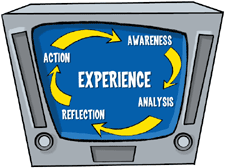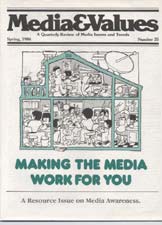Blueprint for Response-Ability
|
This article originally appeared in Issue# 35
|
How Media&Values magazine helped to jump-start media literacy in the U.S.
Like fish in water, we are seldom aware of the media environment that continually shapes our lives, values and attitudes.
But today's mass media and telecommunications technology is creating a social environment that is radically different from the society of 25 or even 10 years ago. And as Michael Schudson reminds us, that environment is all the more significant for pervading every aspect of our lives.
A friend of mine who is an elementary teacher recently commented, "I don't know much about media, but I know it's a problem."
We can all echo her insight at one time or another. We may not understand the connections and interconnection of today's media systems but we are more and more aware of the cumulative impact of television and video, computers, music, advertising, even the telephone, on our families, our children, and ourselves.
As we become conscious of the media in our lives and seek to cope with the challenge it represents, there are two pitfalls we need to avoid.
The first is focusing only on the negative impact of media.
While there is legitimate concern, for example, that television violence has created a "mean world" syndrome — especially among the elderly who are heavy viewers — interactive video programs, linked to computers and placed in public health facilities, are helping more and more people make better decisions when faced with complex issues like bringing an elderly parent into the home or altering one's lifestyle following a heart attack.
The usual reason we fall into negativity is because we fear an unknown future. What we are witnessing today is a major shift from an industrial-based economy to an information-based one. It is as profound — and scary — as the earlier shift from agriculture to industry.
But while it is always important to question "what price progress?" and to regularly monitor the social impact of technological change, to focus only on the negative implications is to put our heads in the sand and ignore the positive potential of new media and technology to reduce human error, alleviate pain, and expand horizons beyond our limited vision.
A second pitfall is to see media issues only as isolated problems or single issues with simple solutions.
Although our experience of media is usually personal, even private:
- We watch television, usually alone, in our home or room;
- We listen to music on pocket size tape decks with earphones;
- We read magazines and newspapers;
- We use computers to manipulate and store information from our brains.
It is important, in our post-modern society, to view media as a system — with economic, political, cultural and social ramifications.
Indeed, without such a view, it is all too easy to be paralyzed by problems that are bigger than we can personally solve and to become victims rather than agents of change.
Effecting Change
As the editor of Media&Values, I am often asked if anything can really be done about issues like sexual violence in the media, or bias in the news or the impact of advertising on promoting a consumer lifestyle.
In truth, it seems that the various media education movements of the past two decades have been inadequate to the task. Perhaps it's because media issues do not mobilize people like hunger or disease or because media touches the intimate parts of people's lives (self-identity, family relationships, etc.) where change is slow.
But in the meantime mass media and new technology continue to confront us with social and cultural challenges that seem to increase as exponentially as the power of the technology itself.
At Media&Values, we think it's time for a new approach: applying the principles of reflection / action (developed in recent years by the social justice movement) to the systemic media issues facing us today.
Where once we may have felt powerless in the face of an ever-expanding media environment, these principles give us a strategy, a blueprint, for responding positively and creatively to life in today's Media Age.
Introducing Social Analysis
Based on the work of Paulo Friere in his classic The Pedagogy of the Oppressed, and developed further by Juan Luis Segundo in The Liberation of Theology, an approach to solving social problems has emerged that has four identifiable "moments" in a continually upward spiral:
|
 |
These four steps, when applied to any social problem, whether homeless persons on the street or children whose nightmares stem from television images, provide a method of interpretation that asks: Why are things the way they are? Do they have to be this way?
Often simply called "social analysis" by the social justice community, this method differs from academic social investigation (known as "cultural studies") by focusing on personal action or planning for change rather than simply understanding the scope of a problem in a detached and abstract manner.
Social analysis requires, in effect, that we "do our homework" to examine the causes and connections of social problems. And going further, to ask ourselves what is demanded of us as members of society or people of faith.
Doing Social Analysis of Media Experience
The way we see a problem determines how we respond to it. Looking at an issue through social analysis allows us to broaden our vision and transcend our internal blinders.
Depending on the problem at hand, working through an issue using social analysis may take hours — or months. In some ways analysis never stops because even when we organize for action, that experience will lead us to new awareness which in turn requires another level of analysis, reflection and action.
While it is important to think through a situation ourselves, it is valuable to do formal social analysis in a group setting.
For those who are aware of the impact of media on families, young people, children, the elderly, etc., Media&Values serves as a tool for doing social analysis of media issues — by teachers, youth leaders, counselors, pastors, parents, and others.
Notice, for example, how the magazine is put together.
- Each issue of Media&Values focuses on a specific media concern facing our society.
- The first article raises our awareness of the issue and what some of the major questions are.
- Further articles develop political, economic, social, cultural or historical background to help readers (alone or in study groups) analyze the issue. Even the illustrations, quotes and sidebars add to one's understanding of the topic.
- A list of resources provides further help for analysis of the subject.
- Next, Media&Values columnists provide thoughtful reflection and suggestions for positive action for pastors, youth leaders, family counselors, teachers, social justice leaders, and those concerned for women, minorities and international matters. Columnists represent a wide variety of professional backgrounds and each is supported by an advisory board of denominational, academic and professional leaders in their area.
- Finally, the back page focuses on one person who has "gotten involved" in the issue and whose actions can provide a model for others.
Mobilizing a Movement
By creating Media&Values, the organizations and denominations sponsoring it hope that those who use the magazine regularly will form the basis of a new media awareness movement at the local level.
Unlike other media action efforts which have focused on specific issues like telephone access or children's television, a media reflection/action movement can be applied to any issue, from the availability of sexually violent videos to teenagers to the impact of junk food advertising on family health.
What is needed in the face of such concerns is the insight to process the problem clearly from initial awareness to appropriate action. The intervening steps of analysis and reflection provide a context for understanding the complexity of the problem and, at the same time, prevent an emotional escalation that too often leads to ineffective action on one hand or paralyzed inaction on the other.
To bring this movement about, community and religious leaders must begin to see the media connection in all areas of social and pastoral work. At the same time, media specialists and communicators must bring an educational connection to their media expertise.
A special challenge for linking these fields is offered specifically to audio-visual educators and those who staff media resource centers.
In the past 20 years, their job has evolved from teaching others how to use media hardware to selecting — or creating —media materials for education, particularly education in social issues like hunger or justice in South Africa.
Now the need is for sensitive specialists who grasp that the new media technology is itself a justice issue and that positive leadership Is needed to mobilize a media awareness movement - -using Media&Values as a key resource — within our churches, synagogues, schools and community centers.
Those who accept this challenge will find a whole new depth to education and ministry as they empower families and the next generation to survive, even flourish in the media environment that characterizes our Information Age.



